Bibliometric Analysis of Research Progress and Perspectives of Deep Underground Rockburst Using Knowledge Mapping Method
Abstract
:1. Introduction
2. Data and Methods for Bibliometric Analysis
2.1. Literature Dataset Acquisition and Compilation
2.2. Method for Bibliometric Analysis
3. Results
3.1. Annual Publication Numbers and Publication Trend
3.2. Scientific Collaborative Networks Analysis
3.2.1. International Collaboration Networks
3.2.2. Collaboration Networks of Research Institutions
3.2.3. Author Collaboration Networks
3.3. Co-Citation Analysis of the Literature
3.3.1. Co-Cited Research Journals
3.3.2. Co-Cited Articles on Deep Underground Rockburst
3.4. Keywords Co-Occurrence Analysis
3.4.1. Analysis of Keywords Co-Occurrence and Citation Burst
3.4.2. Keyword Clustering Analysis
3.4.3. Keywords Timeline of Clusters
4. Discussion
4.1. Current Research Hotspots
4.2. Future Research Perspectives
- (1)
- Deep rock masses, compared to shallow rock masses, have more complex geological origins and exist in unique environments with high stress, high temperature, high pore pressure, and intense mining disturbances. However, the current research on deep rockburst issues often only considers the high-stress environment in deep rocks, paying less attention to the high-temperature and high-pore-pressure mechanical environments. Therefore, future research on deep rock mass burst should approach studies from the perspective of multi-field coupling of stress–flow–temperature and thoroughly investigate the mechanisms and predictions of rockburst in deep engineering.
- (2)
- Most prediction methods for rockburst involve the use of analytical algorithms, combining multiple quantitative criteria for prediction, and then validating them with existing engineering measurements. Although these methods have a certain degree of rationality, they still have issues, such as an incomplete selection of indicators, neglecting major factors that influence rockburst occurrences, inconsistent classification criteria, and low applicability of methods. Prediction methods based on field monitoring, which enable real-time monitoring of excavation conditions, show promising applications. However, further research is needed on the arrangement of monitoring devices and the determination and applicability of intensity classification methods. Currently, finding a method that accurately predicts rockburst in the majority of engineering scenarios remains challenging. Therefore, establishing prediction methods for rockburst with broader applicability and studying their feasibility and effectiveness will be the focus and difficulty of rockburst disaster research.
- (3)
- In the existing research on deep rock mass burst, little consideration has been given to special jointed rock masses, such as columnar joints, and geological structures, such as faults. There is a lack of consideration for the anisotropic mechanical properties of rocks and the external complex and uncertain environments. This is also a significant reason for the relatively low accuracy of deep rockburst prediction and prevention methods. Therefore, in future research, in-depth studies should be conducted on complex rock conditions and geological structures in deep areas to improve the accuracy of rock mass burst predictions under various conditions.
5. Conclusions
- (1)
- In the collaboration network analysis, it is evident that China holds an absolute core position in the field of deep rockburst research globally and has connections with other countries. The proportion of publications authored by Chinese scholars is as high as 83.01%. Among them, 115 articles were led by the China University of Mining and Technology, which is the largest research institution in deep rockburst studies. The overall authorship network exhibits an overall dispersed and small-scale aggregation pattern, indicating relatively close communication and collaboration within research teams but scattered collaboration between teams.
- (2)
- In the citation analysis, the International Journal of Rock Mechanics and Mining Sciences, Rock Mechanics and Rock Engineering, and Tunneling and Underground Space Technology are the highest cited journals, demonstrating close co-citation relationships with other journals. The most highly cited article is Predicting Rock Burst Hazard with Incomplete Data using Bayesian Networks by Ning, Li et al. [71], which has been cited 24 times in the field of deep rockburst. This article establishes rockburst prediction criteria based on five parameters: tunnel depth, maximum tangential stress of surrounding rock, uniaxial compressive strength of surrounding rock, uniaxial tensile strength, and elastic energy index, providing strong guidance for subsequent rockburst predictions.
- (3)
- Based on the keyword co-occurrence analysis, the keyword “prediction” has had the highest frequency of appearance in the past two decades. Rational prediction of rockburst is a necessary prerequisite for ensuring engineering safety and taking effective measures in advance. Therefore, rockburst prediction is a hot topic in deep rockburst research. Through keyword citation burst analysis, it can be observed that since 2016, with the continuous advancement of deep engineering, the issue of deep rockburst has gained widespread attention and research. Understanding the rockburst mechanism, tendency prediction, and protective measures for deep rock mass engineering will also become frontier hot topics for further human exploration into deep rock masses.
- (4)
- In the clustering analysis, the main clusters identified are: #1—conventional criteria, #2—acoustic emission, #3—geology, #4—seismic velocity tomography, #5—dynamic disturbance, #6—rockburst prediction, #7—bursting liability, #8—chip evacuation forces, and #9—phosphorylation. These nine major clusters represent the current research topics.
- (5)
- In terms of future research prospects, future studies on deep rock mass burst should approach the topic from the perspective of multi-field coupling of stress–flow–temperature, considering special jointed rock masses, such as columnar joints, and geological structures, such as faults. Moreover, studies should incorporate the anisotropic mechanical properties of rocks and the complex and uncertain external environments. The focus should be on understanding the mechanisms of rockbursts, establishing prediction methods with broader applicability, and studying their feasibility and effectiveness.
Author Contributions
Funding
Institutional Review Board Statement
Informed Consent Statement
Data Availability Statement
Acknowledgments
Conflicts of Interest
References
- Zhang, C.Q.; Feng, X.T.; Zhou, H.; Qiu, S.L.; Wu, W.P. Case Histories of Four Extremely Intense Rockbursts in Deep Tunnels. Rock Mech. Rock Eng. 2012, 45, 275–288. [Google Scholar] [CrossRef]
- Martin, C.D.; Christiansson, R. Estimating the Potential for Spalling around a Deep Nuclear Waste Repository in Crystalline Rock. Int. J. Rock Mech. Min. Sci. 2009, 46, 219–228. [Google Scholar] [CrossRef]
- Gong, F.Q.; Wu, W.X.; Li, T.B.; Si, X.F. Experimental Simulation and Investigation of Spalling Failure of Rectangular Tunnel under Different Three-Dimensional Stress States. Int. J. Rock Mech. Min. Sci. 2019, 122, 14. [Google Scholar] [CrossRef]
- Li, Y.; Jianguo, Z. Study on the Geomechanical Patterns of Rockburst in the Access Tunnel of a Hydroelectric Power Station in Southwest China. Mod. Tunn. Technol. 2009, 46, 41–46. [Google Scholar]
- Zhu, S.; Zheng, J.H.; Zhu, Z.D.; Zhu, Q.Z.; Zhou, L.M. Experiments on Three-Dimensional Flaw Dynamic Evolution of Transparent Rock-Like Material under Osmotic Pressure. Tunn. Undergr. Space Technol. 2022, 128, 13. [Google Scholar] [CrossRef]
- Lim, M.S.C.; Murray, J.; Dowdeswell, R.J.; Glynn, J.R.; Sonnenberg, P. Unnatural Deaths in South African Platinum Miners, 1992–2008. PLoS ONE 2011, 6, e22807. [Google Scholar] [CrossRef] [PubMed]
- Wang, L.; Zhu, Z.; Zhu, S.; Wu, J. A Case Study on Tunnel Excavation Stability of Columnar Jointed Rock Masses with Different Dip Angles in the Baihetan Diversion Tunnel. Symmetry 2023, 15, 1232. [Google Scholar] [CrossRef]
- Zhu, Z.; Wang, L.; Zhu, S.; Wu, J. Study on the Anisotropy of Strength Properties of Columnar Jointed Rock Masses Using a Geometric Model Reconstruction Method Based on a Single-Random Movement Voronoi Diagram of Uniform Seed Points. Symmetry 2023, 15, 944. [Google Scholar] [CrossRef]
- Sepehri, M.; Apel, D.B.; Adeeb, S.; Leveille, P.; Hall, R.A. Evaluation of Mining-Induced Energy and Rockburst Prediction at a Diamond Mine in Canada Using a Full 3d Elastoplastic Finite Element Model. Eng. Geol. 2020, 266, 17. [Google Scholar] [CrossRef]
- Ortlepp, W.D. Rasim Comes of Age–A Review of the Contribution to the Understanding and Control of Mine Rockbursts. In Proceedings of the Sixth International Symposium on Rockburst and Seismicity in Mines, Melbourne, Australia, 9–11 March 2005; pp. 3–20. [Google Scholar]
- Cai, W.; Dou, L.M.; Zhang, M.; Cao, W.Z.; Shi, J.Q.; Feng, L.F. A Fuzzy Comprehensive Evaluation Methodology for Rock Burst Forecasting Using Microseismic Monitoring. Tunn. Undergr. Space Technol. 2018, 80, 232–245. [Google Scholar] [CrossRef]
- Chen, S.J.; Feng, F.; Wang, Y.J.; Li, D.Y.; Huang, W.P.; Zhao, X.D.; Jiang, N. Tunnel Failure in Hard Rock with Multiple Weak Planes Due to Excavation Unloading of in-Situ Stress. J. Cent. South Univ. 2020, 27, 2864–2882. [Google Scholar] [CrossRef]
- Dong, L.J.; Sun, D.Y.; Han, G.J.; Li, X.B.; Hu, Q.C.; Shu, L. Velocity-Free Localization of Autonomous Driverless Vehicles in Underground Intelligent Mines. IEEE Trans. Veh. Technol. 2020, 69, 9292–9303. [Google Scholar] [CrossRef]
- Dong, L.J.; Zou, W.; Li, X.B.; Shu, W.W.; Wang, Z.W. Collaborative Localization Method Using Analytical and Iterative Solutions for Microseismic/Acoustic Emission Sources in the Rockmass Structure for Underground Mining. Eng. Fract. Mech. 2019, 210, 95–112. [Google Scholar] [CrossRef]
- Faradonbeh, R.S.; Haghshenas, S.S.; Taheri, A.; Mikaeil, R. Application of Self-Organizing Map and Fuzzy C-Mean Techniques for Rockburst Clustering in Deep Underground Projects. Neural Comput. Appl. 2020, 32, 8545–8559. [Google Scholar] [CrossRef]
- Faradonbeh, R.S.; Taheri, A. Long-Term Prediction of Rockburst Hazard in Deep Underground Openings Using Three Robust Data Mining Techniques. Eng. Comput. 2019, 35, 659–675. [Google Scholar] [CrossRef]
- Faradonbeh, R.S.; Taheri, A.; Sousa, L.R.E.; Karakus, M. Rockburst Assessment in Deep Geotechnical Conditions Using True-Triaxial Tests and Data-Driven Approaches. Int. J. Rock Mech. Min. Sci. 2020, 128, 19. [Google Scholar] [CrossRef]
- Feng, G.L.; Feng, X.T.; Chen, B.R.; Xiao, Y.X.; Liu, G.F.; Zhang, W.; Hu, L. Characteristics of Microseismicity During Breakthrough in Deep Tunnels: Case Study of Jinping-Ii Hydropower Station in China. Int. J. Geomech. 2020, 20, 11. [Google Scholar] [CrossRef]
- Atsushi, S.; Hani, S.M. Numerical Investigation into Pillar Failure Induced by Time-Dependent Skin Degradation. Int. J. Min. Sci. Technol. 2017, 27, 591–597. [Google Scholar]
- Feng, G.L.; Feng, X.T.; Chen, B.R.; Xiao, Y.X.; Zhao, Z.N. Effects of Structural Planes on the Microseismicity Associated with Rockburst Development Processes in Deep Tunnels of the Jinping-Ii Hydropower Station, China. Tunn. Undergr. Space Technol. 2019, 84, 273–280. [Google Scholar] [CrossRef]
- Ghasemi, E.; Gholizadeh, H.; Adoko, A.C. Evaluation of Rockburst Occurrence and Intensity in Underground Structures Using Decision Tree Approach. Eng. Comput. 2020, 36, 213–225. [Google Scholar] [CrossRef]
- Ghorbani, M.; Shahriar, K.; Sharifzadeh, M.; Masoudi, R. A Critical Review on the Developments of Rock Support Systems in High Stress Ground Conditions. Int. J. Min. Sci. Technol. 2020, 30, 555–572. [Google Scholar] [CrossRef]
- Guo, Y.D.; Huang, L.Q.; Li, X.B.; Chen, J.Z.; Sun, J.N. Experimental Investigation on the Effects of Thermal Treatment on the Physical and Mechanical Properties of Shale. J. Nat. Gas Sci. Eng. 2020, 82, 16. [Google Scholar]
- He, B.G.; Zelig, R.; Hatzor, Y.H.; Feng, X.T. Rockburst Generation in Discontinuous Rock Masses. Rock Mech. Rock Eng. 2016, 49, 4103–4124. [Google Scholar] [CrossRef]
- He, M.C.; Li, C.; Gong, W.L.; Sousa, L.R.; Li, S.L. Dynamic Tests for a Constant-Resistance-Large-Deformation Bolt Using a Modified Shtb System. Tunn. Undergr. Space Technol. 2017, 64, 103–116. [Google Scholar] [CrossRef]
- He, M.C.; Sousa, L.R.E.; Miranda, T.; Zhu, G.L. Rockburst Laboratory Tests Database–Application of Data Mining Techniques. Eng. Geol. 2015, 185, 116–130. [Google Scholar] [CrossRef]
- Hudyma, M.; Potvin, Y.H. An Engineering Approach to Seismic Risk Management in Hardrock Mines. Rock Mech. Rock Eng. 2010, 43, 891–906. [Google Scholar] [CrossRef]
- Jiang, Q.A.; Feng, X.T.; Xiang, T.B.; Su, G.S. Rockburst Characteristics and Numerical Simulation Based on a New Energy Index: A Case Study of a Tunnel at 2500 M Depth. Bull. Eng. Geol. Environ. 2010, 69, 381–388. [Google Scholar] [CrossRef]
- Hoek, E.; Brown, E.T. Underground Excavations in Rock; CRC Press: Boca Raton, FL, USA, 1980. [Google Scholar]
- Zhou, J.; Li, X.B.; Mitri, H.S. Evaluation Method of Rockburst: State-of-the-Art Literature Review. Tunn. Undergr. Space Technol. 2018, 81, 632–659. [Google Scholar] [CrossRef]
- Zhang, J.J.; Fu, B.J.; Li, Z.K.; Song, S.W.; Shang, Y.J. Criterion and Classification for Strain Mode Rockbursts Based on Five-Factor Comprehensive Method. In Proceedings of the 12th ISRM International Congress on Rock Mechanics, Beijing, China, 17–21 October 2011. [Google Scholar]
- Gong, F.Q.; Yan, J.Y.; Li, X.B.; Luo, S. A Peak-Strength Strain Energy Storage Index for Rock Burst Proneness of Rock Materials. Int. J. Rock Mech. Min. Sci. 2019, 117, 76–89. [Google Scholar] [CrossRef]
- Gong, F.Q.; Wang, Y.L.; Luo, S. Rockburst Proneness Criteria for Rock Materials: Review and New Insights. J. Cent. South Univ. 2020, 27, 2793–2821. [Google Scholar] [CrossRef]
- Sousa, L.R.E.; Miranda, T.; Sousa, R.L.E.; Tinoco, J. The Use of Data Mining Techniques in Rockburst Risk Assessment. Engineering 2017, 3, 552–558. [Google Scholar] [CrossRef]
- Su, G.S.; Feng, X.T.; Wang, J.H.; Jiang, J.Q.; Hu, L.H. Experimental Study of Remotely Triggered Rockburst Induced by a Tunnel Axial Dynamic Disturbance under True-Triaxial Conditions. Rock Mech. Rock Eng. 2017, 50, 2207–2226. [Google Scholar] [CrossRef]
- Tarasov, B.G.; Randolph, M.F. Frictionless Shear at Great Depth and Other Paradoxes of Hard Rocks. Int. J. Rock Mech. Min. Sci. 2008, 45, 316–328. [Google Scholar] [CrossRef]
- Wang, S.F.; Huang, L.Q.; Li, X.B. Analysis of Rockburst Triggered by Hard Rock Fragmentation Using a Conical Pick under High Uniaxial Stress. Tunn. Undergr. Space Technol. 2020, 96, 15. [Google Scholar] [CrossRef]
- Wang, S.F.; Li, X.B.; Yao, J.R.; Gong, F.Q.; Li, X.; Du, K.; Tao, M.; Huang, L.Q.; Du, S.L. Experimental Investigation of Rock Breakage by a Conical Pick and Its Application to Non-Explosive Mechanized Mining in Deep Hard Rock. Int. J. Rock Mech. Min. Sci. 2019, 122, 14. [Google Scholar] [CrossRef]
- Wei, C.C.; Zhang, C.G.; Canbulat, I.; Cao, A.Y.; Dou, L.M. Evaluation of Current Coal Burst Control Techniques and Development of a Coal Burst Management Framework. Tunn. Undergr. Space Technol. 2018, 81, 129–143. [Google Scholar] [CrossRef]
- Meseguer-Sánchez, V.; Gálvez-Sánchez, F.J.; López-Martínez, G.; Molina-Moreno, V. Corporate Social Responsibility and Sustainability. A Bibliometric Analysis of Their Interrelations. Sustainability 2021, 13, 1636. [Google Scholar] [CrossRef]
- Liu, K.; Xiaojin, G.; Chunming, L.; Keyi, Z.; Xiaohua, Y.; Rongxin, F.; Yi, L.; Fangming, Y. Global Perspectives and Future Research Directions for the Phytoremediation of Heavy Metal-Contaminated Soil: A Knowledge Mapping Analysis from 2001 to 2020. Front. Environ. Sci. Eng. 2021, 16, 73. [Google Scholar] [CrossRef]
- Wang, L.Y.; Luo, D.; Hamdaoui, O.; Vasseghian, Y.; Momotko, M.; Boczkaj, G.; Kyzas, G.Z.; Wang, C.Q. Bibliometric Analysis and Literature Review of Ultrasound-Assisted Degradation of Organic Pollutants. Sci. Total Environ. 2023, 876, 16. [Google Scholar] [CrossRef]
- Feng, X.T.; Liu, J.P.; Chen, B.R.; Xiao, Y.X.; Feng, G.L.; Zhang, F.P. Monitoring, Warning, and Control of Rockburst in Deep Metal Mines. Engineering 2017, 3, 538–545. [Google Scholar] [CrossRef]
- Keneti, A.; Sainsbury, B.A. Review of Published Rockburst Events and Their Contributing Factors. Eng. Geol. 2018, 246, 361–373. [Google Scholar] [CrossRef]
- Sajjad, A.; Shahriar, K.; Madani, S.H. Developing Intelligent Classification Models for Rock Burst Prediction after Recognizing Significant Predictor Variables, Section 2: Designing Classifiers. Tunn. Undergr. Space Technol. 2019, 84, 522–537. [Google Scholar]
- Shu, Z.; Zhu, Z.; Wang, L.; Wu, J. Research Progress and Hot Spot Analysis of the Propagation and Evolution Law of Prefabricated Cracks in Defective Rocks. Materials 2023, 16, 4623. [Google Scholar]
- Fansong, L.; Li, R.Y.M.; James, M.; Crabbe, C.; Pu, R. Economic Development and Construction Safety Research: A Bibliometrics Approach. Saf. Sci. 2022, 145, 105519. [Google Scholar]
- Chen, C.M. Searching for Intellectual Turning Points: Progressive Knowledge Domain Visualization. Proc. Natl. Acad. Sci. USA 2004, 101, 5303–5310. [Google Scholar] [CrossRef]
- Chaomei, C.; Chen, Y.; Hou, J.; Liang, Y. Citespace Ⅱ: Detecting and Visualizing Emerging Trends and Transient Patterns in Scientific Literature. J. China Soc. Sci. Tech. Inf. 2009, 28, 401–421. [Google Scholar]
- David, A.; Yigitcanlar, T.; Li, R.Y.M.; Corchado, J.M.; Cheong, P.H.; Mossberger, K.; Mehmood, R. Understanding Local Government Digital Technology Adoption Strategies: A Prisma Review. Sustainability 2023, 15, 9645. [Google Scholar]
- Huang, R.H.; Yang, X.M. 8 Analysis and Research Hotspots of Ceramic Materials in Textile Application. J. Ceram. Process. Res. 2022, 23, 312–319. [Google Scholar]
- Cheng, K.M.; Guo, Q.; Shen, Z.F.; Yang, W.G.; Wang, Y.L.; Sun, Z.J.; Wu, H.Y. Bibliometric Analysis of Global Research on Cancer Photodynamic Therapy: Focus on Nano-Related Research. Front. Pharmacol. 2022, 13, 19. [Google Scholar] [CrossRef]
- Guo, Y.; Xu, Z.Y.R.; Cai, M.T.; Gong, W.X.; Shen, C.H. Epilepsy with Suicide: A Bibliometrics Study and Visualization Analysis Via Citespace. Front. Neurol. 2022, 12, 10. [Google Scholar] [CrossRef]
- Linton, C.F. A Set of Measures of Centrality Based on Betweenness. Sociometry 1977, 40, 35–41. [Google Scholar]
- Chen, C.M. Predictive Effects of Structural Variation on Citation Counts. J. Am. Soc. Inf. Sci. Technol. 2012, 63, 431–449. [Google Scholar] [CrossRef]
- Konicek, P.; Waclawik, P. Stress Changes and Seismicity Monitoring of Hard Coal Longwall Mining in High Rockburst Risk Areas. Tunn. Undergr. Space Technol. 2018, 81, 237–251. [Google Scholar] [CrossRef]
- Li, B.L.; Lan, J.Q.; Si, G.Y.; Lin, G.P.; Hu, L.Q. Nmr-Based Damage Characterisation of Backfill Material in Host Rock under Dynamic Loading. Int. J. Min. Sci. Technol. 2020, 30, 329–335. [Google Scholar] [CrossRef]
- Li, C.C.; Mikula, P.; Simser, B.; Hebblewhite, B.; Joughin, W.; Feng, X.W.; Xu, N.W. Discussions on Rockburst and Dynamic Ground Support in Deep Mines. J. Rock Mech. Geotech. Eng. 2019, 11, 1110–1118. [Google Scholar] [CrossRef]
- Li, X.B.; Gong, F.Q.; Tao, M.; Dong, L.J.; Du, K.; Ma, C.D.; Zhou, Z.L.; Yin, T.B. Failure Mechanism and Coupled Static-Dynamic Loading Theory in Deep Hard Rock Mining: A Review. J. Rock Mech. Geotech. Eng. 2017, 9, 767–782. [Google Scholar] [CrossRef]
- Li, X.B.; Li, C.J.; Cao, W.Z.; Tao, M. Dynamic Stress Concentration and Energy Evolution of Deep-Buried Tunnels under Blasting Loads. Int. J. Rock Mech. Min. Sci. 2018, 104, 131–146. [Google Scholar] [CrossRef]
- Chaomei, C. Science Mapping: A Systematic Review of the Literature. J. Data Inf. Sci. 2017, 2, 1–40. [Google Scholar]
- Chen, C.M.; Song, M. Visualizing a Field of Research: A Methodology of Systematic Scientometric Reviews. PLoS ONE 2019, 14, e0223994. [Google Scholar] [CrossRef] [PubMed]
- Chu, P.L.; Wang, T.; Zheng, J.L.; Xu, C.Q.; Yan, Y.J.; Ma, Q.S.; Meng-chen, Y.; Da-sheng, T. Global and Current Research Trends of Unilateral Biportal Endoscopy/Biportal Endoscopic Spinal Surgery in the Treatment of Lumbar Degenerative Diseases: A Bibliometric and Visualization Study. Orthop. Surg. 2022, 14, 635–643. [Google Scholar] [CrossRef]
- Shen, Z.F.; Wu, H.Y.; Chen, Z.S.; Hu, J.T.; Pan, J.X.; Kong, J.Q.; Lin, T.X. The Global Research of Artificial Intelligence on Prostate Cancer: A 22-Year Bibliometric Analysis. Front. Oncol. 2022, 12, 16. [Google Scholar] [CrossRef] [PubMed]
- Yin, M.C.; Wang, H.S.; Sun, Y.J.; Xu, C.Q.; Ye, J.; Ma, J.M.; Wang, D.; Mo, W. Global Trends of Researches on Lumbar Spinal Stenosis a Bibliometric and Visualization Study. Clin. Spine Surg. 2022, 35, E259–E266. [Google Scholar] [CrossRef] [PubMed]
- Fu, L.; Mao, S.D.; Chen, F.; Zhao, S.C.; Su, W.T.; Lai, G.S.; Yu, A.M.; Lin, C.T. Graphene-Based Electrochemical Sensors for Antibiotic Detection in Water, Food and Soil: A Scientometric Analysis in Citespace (2011–2021). Chemosphere 2022, 297, 14. [Google Scholar] [CrossRef] [PubMed]
- Sabe, M.; Pillinger, T.; Kaiser, S.; Chen, C.M.; Taipale, H.; Tanskanen, A.; Tiihonen, J.; Leucht, S.; Correll, C.U.; Solmi, M. Half a Century of Research on Antipsychotics and Schizophrenia: A Scientometric Study of Hotspots, Nodes, Bursts, and Trends. Neurosci. Biobehav. Rev. 2022, 136, 13. [Google Scholar] [CrossRef] [PubMed]
- Shen, J.M.; Shen, H.; Ke, L.X.; Chen, J.L.; Dang, X.; Liu, B.X.; Hua, Y.P. Knowledge Mapping of Immunotherapy for Hepatocellular Carcinoma: A Bibliometric Study. Front. Immunol. 2022, 13, 12. [Google Scholar] [CrossRef]
- Wu, H.Y.; Cheng, K.M.; Tong, L.J.; Wang, Y.L.; Yang, W.G.; Sun, Z.M. Knowledge Structure and Emerging Trends on Osteonecrosis of the Femoral Head: A Bibliometric and Visualized Study. J. Orthop. Surg. Res. 2022, 17, 14. [Google Scholar] [CrossRef]
- Cheng, K.M.; Guo, Q.; Yang, W.G.; Wang, Y.L.; Sun, Z.J.; Wu, H.Y. Mapping Knowledge Landscapes and Emerging Trends of the Links between Bone Metabolism and Diabetes Mellitus: A Bibliometric Analysis from 2000 to 2021. Front. Public Health 2022, 10, 18. [Google Scholar] [CrossRef] [PubMed]
- Wu, H.Y.; Cheng, K.M.; Guo, Q.; Yang, W.G.; Tong, L.J.; Wang, Y.L.; Sun, Z.M. Mapping Knowledge Structure and Themes Trends of Osteoporosis in Rheumatoid Arthritis: A Bibliometric Analysis. Front. Med. 2021, 8, 17. [Google Scholar] [CrossRef]
- Li, N.; Feng, X.D.; Jimenez, R. Predicting Rock Burst Hazard with Incomplete Data Using Bayesian Networks. Tunn. Undergr. Space Technol. 2017, 61, 61–70. [Google Scholar] [CrossRef]
- Zhou, J.; Li, X.B.; Mitri, H.S. Classification of Rockburst in Underground Projects: Comparison of Ten Supervised Learning Methods. J. Comput. Civ. Eng. 2016, 30, 19. [Google Scholar] [CrossRef]
- Cai, W.; Dou, L.M.; Si, G.Y.; Cao, A.Y.; He, J.; Liu, S. A Principal Component Analysis/Fuzzy Comprehensive Evaluation Model for Coal Burst Liability Assessment. Int. J. Rock Mech. Min. Sci. 2016, 81, 62–69. [Google Scholar] [CrossRef]
- Mazaira, A.; Konicek, P. Intense Rockburst Impacts in Deep Underground Construction and Their Prevention. Can. Geotech. J. 2015, 52, 1426–1439. [Google Scholar] [CrossRef]
- Ma, T.H.; Tang, C.A.; Tang, S.B.; Kuang, L.; Yu, Q.; Kong, D.Q.; Zhu, X. Rockburst Mechanism and Prediction Based on Microseismic Monitoring. Int. J. Rock Mech. Min. Sci. 2018, 110, 177–188. [Google Scholar] [CrossRef]
- Afraei, S.; Shahriar, K.; Madani, S.H. Statistical Assessment of Rock Burst Potential and Contributions of Considered Predictor Variables in the Task. Tunn. Undergr. Space Technol. 2018, 72, 250–271. [Google Scholar] [CrossRef]
- Feng, X.T.; Yu, Y.; Feng, G.L.; Xiao, Y.X.; Chen, B.R.; Jiang, Q. Fractal Behaviour of the Microseismic Energy Associated with Immediate Rockbursts in Deep, Hard Rock Tunnels. Tunn. Undergr. Space Technol. 2016, 51, 98–107. [Google Scholar] [CrossRef]
- Zhong, D.L.; Li, Y.X.; Huang, Y.J.; Hong, X.J.; Li, J.; Jin, R.J. Molecular Mechanisms of Exercise on Cancer: A Bibliometrics Study and Visualization Analysis Via Citespace. Front. Mol. Biosci. 2022, 8, 12. [Google Scholar] [CrossRef] [PubMed]
- Weng, L.; Huang, L.Q.; Taheri, A.; Li, X.B. Rockburst Characteristics and Numerical Simulation Based on a Strain Energy Density Index: A Case Study of a Roadway in Linglong Gold Mine, China. Tunn. Undergr. Space Technol. 2017, 69, 223–232. [Google Scholar] [CrossRef]
- Xie, C.Y.; Nguyen, H.; Bui, X.N.; Nguyen, V.T.; Zhou, J. Predicting Roof Displacement of Roadways in Underground Coal Mines Using Adaptive Neuro-Fuzzy Inference System Optimized by Various Physics-Based Optimization Algorithms. J. Rock Mech. Geotech. Eng. 2021, 13, 1452–1465. [Google Scholar] [CrossRef]
- Xie, H.P.; Lu, J.; Li, C.B.; Li, M.H.; Gao, M.Z. Experimental Study on the Mechanical and Failure Behaviors of Deep Rock Subjected to True Triaxial Stress: A Review. Int. J. Min. Sci. Technol. 2022, 32, 915–950. [Google Scholar] [CrossRef]
- Yin, X.; Liu, Q.S.; Pan, Y.C.; Huang, X.; Wu, J.; Wang, X.Y. Strength of Stacking Technique of Ensemble Learning in Rockburst Prediction with Imbalanced Data: Comparison of Eight Single and Ensemble Models. Nat. Resour. Res. 2021, 30, 1795–1815. [Google Scholar] [CrossRef]
- Zhang, X.Y.; Hu, J.Z.; Xue, H.J.; Mao, W.B.; Gao, Y.B.; Yang, J.; He, M.C. Innovative Approach Based on Roof Cutting by Energy-Gathering Blasting for Protecting Roadways in Coal Mines. Tunn. Undergr. Space Technol. 2020, 99, 12. [Google Scholar] [CrossRef]
- Zhang, Y.; Feng, X.T.; Yang, C.X.; Zhang, X.W.; Sharifzadeh, M.; Wang, Z.F. Fracturing Evolution Analysis of Beishan Granite under True Triaxial Compression Based on Acoustic Emission and Strain Energy. Int. J. Rock Mech. Min. Sci. 2019, 117, 150–161. [Google Scholar] [CrossRef]
- Zhao, X.G.; Wang, J.; Cai, M.; Cheng, C.; Ma, L.K.; Su, R.; Zhao, F.; Li, D.J. Influence of Unloading Rate on the Strainburst Characteristics of Beishan Granite under True-Triaxial Unloading Conditions. Rock Mech. Rock Eng. 2014, 47, 467–483. [Google Scholar] [CrossRef]
- Zhou, J.; Guo, H.Q.; Koopialipoor, M.; Armaghani, D.J.; Tahir, M.M. Investigating the Effective Parameters on the Risk Levels of Rockburst Phenomena by Developing a Hybrid Heuristic Algorithm. Eng. Comput. 2021, 37, 1679–1694. [Google Scholar] [CrossRef]
- Zhu, W.C.; Li, Z.H.; Zhu, L.; Tang, C.A. Numerical Simulation on Rockburst of Underground Opening Triggered by Dynamic Disturbance. Tunn. Undergr. Space Technol. 2010, 25, 587–599. [Google Scholar] [CrossRef]
- Yan, W.T.; Lu, S.; Yang, Y.D.; Ning, W.Y.; Cai, Y.; Hu, X.M.; Zhang, Q.; Xiong, K. Research Trends, Hot Spots and Prospects for Necroptosis in the Field of Neuroscience. Neural Regen. Res. 2021, 16, 1628–1637. [Google Scholar] [PubMed]
- Zeng, L.Y.; Li, R.Y.M.; Zeng, H.L. Weibo Users and Academia? S Foci on Tourism Safety: Implications from Institutional Differences and Digital Divide. Heliyon 2023, 9, 25. [Google Scholar] [CrossRef]
- Chaomei, C.; Ibekwe-Sanjuan, F.; Hou, J. The Structure and Dynamics of Co-Citation Clusters: A Multiple-Perspective Co-Citation Analysis. J. Am. Soc. Inf. Sci. Technol. 2014, 61, 1386–1409. [Google Scholar]
- Chen, Y.X.; Lin, M.W.; Zhuang, D. Wastewater Treatment and Emerging Contaminants: Bibliometric Analysis. Chemosphere 2022, 297, 15. [Google Scholar] [CrossRef]
- Li, R.Y.; Li, B.; Zhu, X.E.; Zhao, J.J.; Pu, R.H.; Song, L.X. Modularity Clustering of Economic Development and Esg Attributes in Prefabricated Building Research. Front. Environ. Sci. 2022, 10, 16. [Google Scholar] [CrossRef]
- Chaomei, C. A Glimpse of the First Eight Months of the Covid-19 Literature on Microsoft Academic Graph: Themes, Citation Contexts, and Uncertainties. Front. Res. Metr. Anal. 2020, 5, 607286. [Google Scholar]
- Liu, X.Q.; Wang, G.; Song, L.B.; Han, G.S.; Chen, W.Z.; Chen, H. A New Rockburst Criterion of Stress-Strength Ratio Considering Stress Distribution of Surrounding Rock. Bull. Eng. Geol. Environ. 2023, 82, 13. [Google Scholar] [CrossRef]
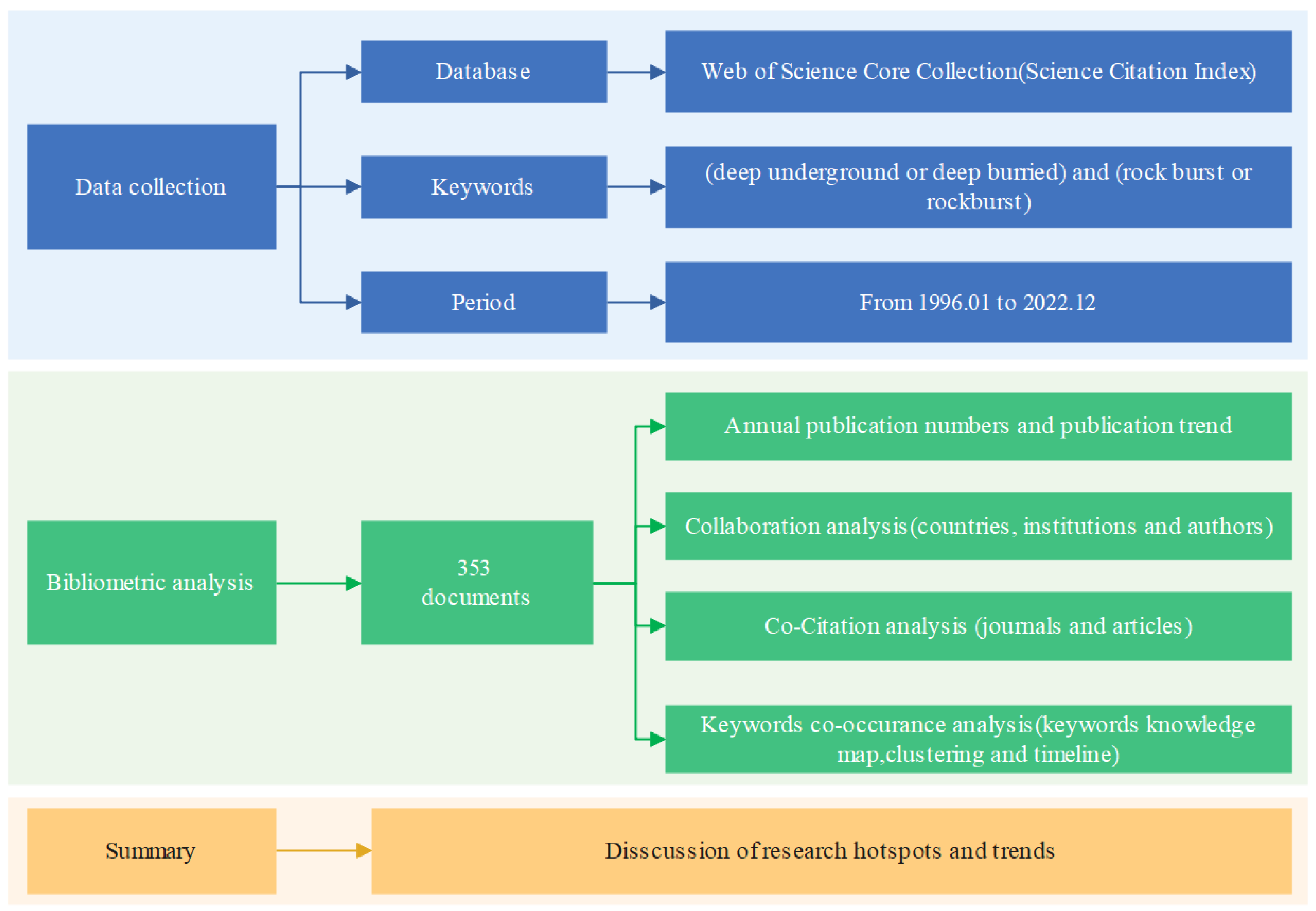
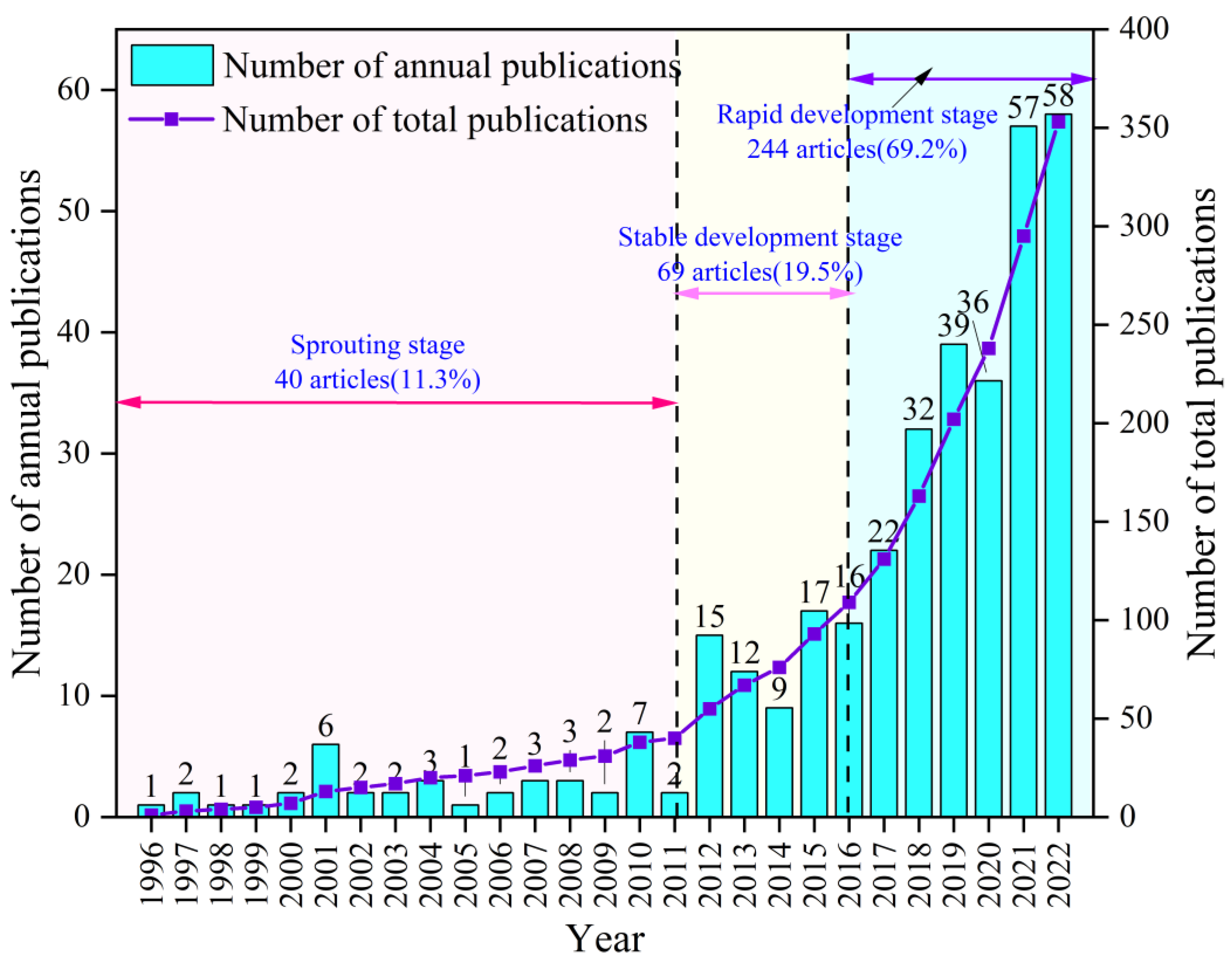
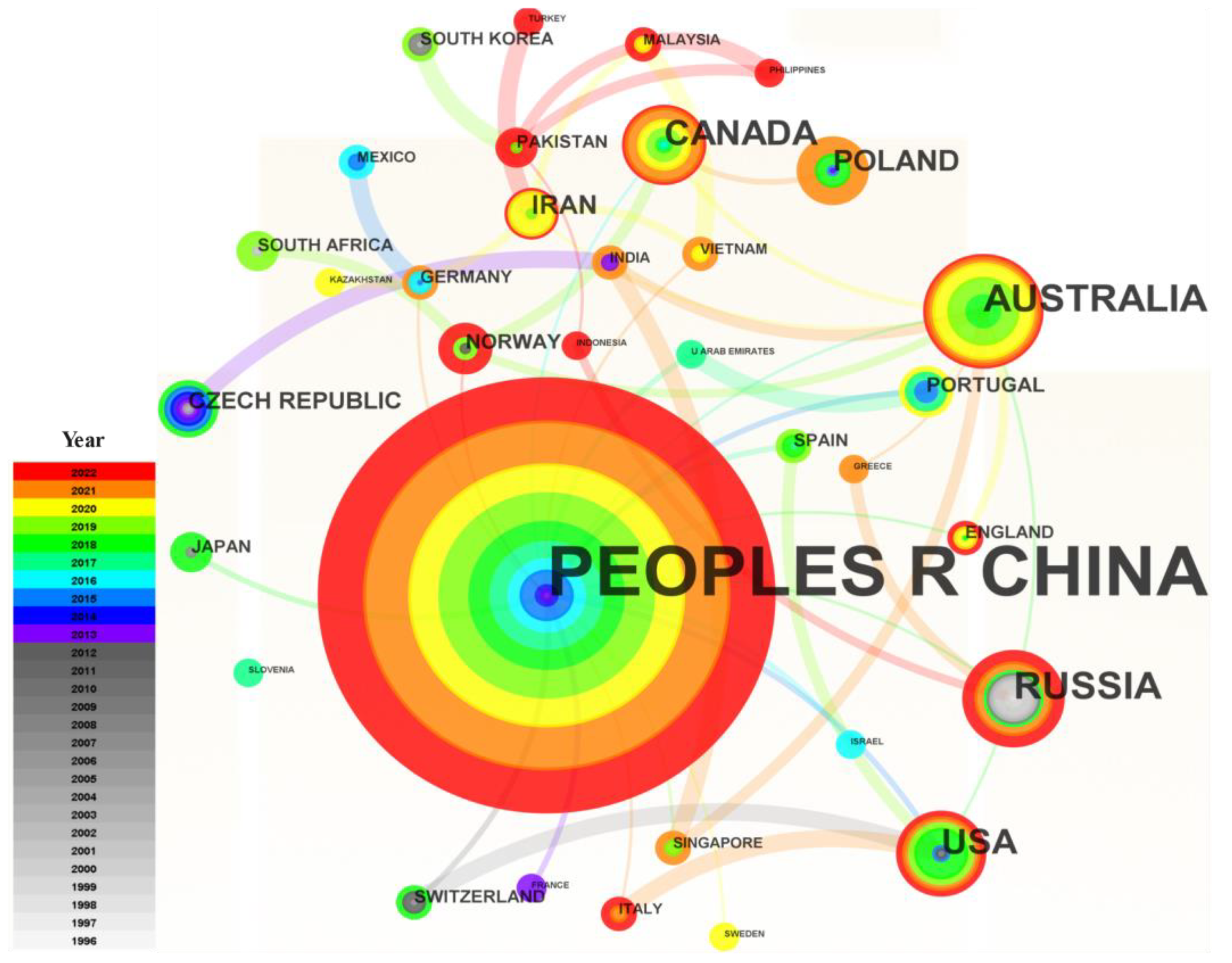
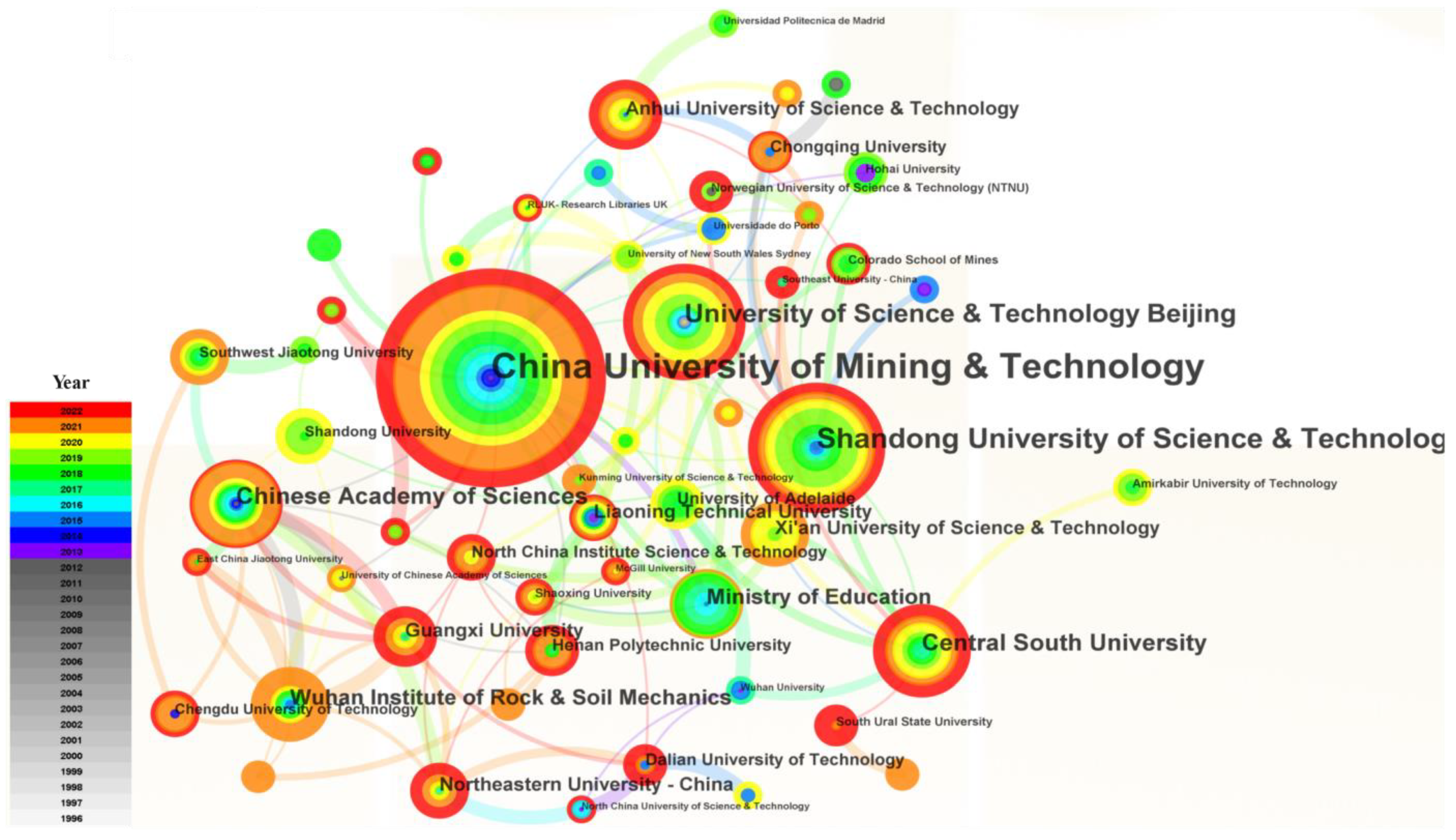
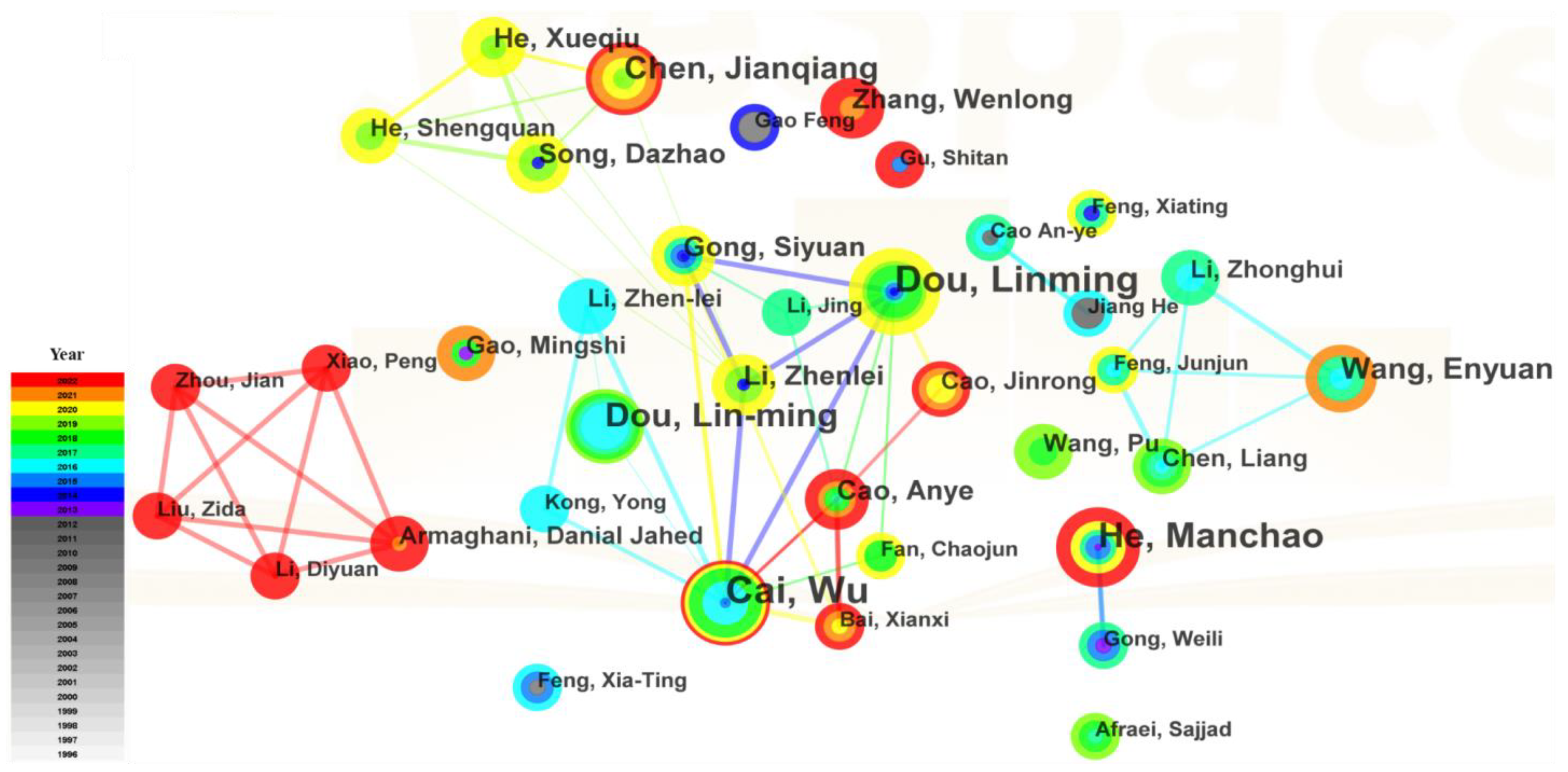
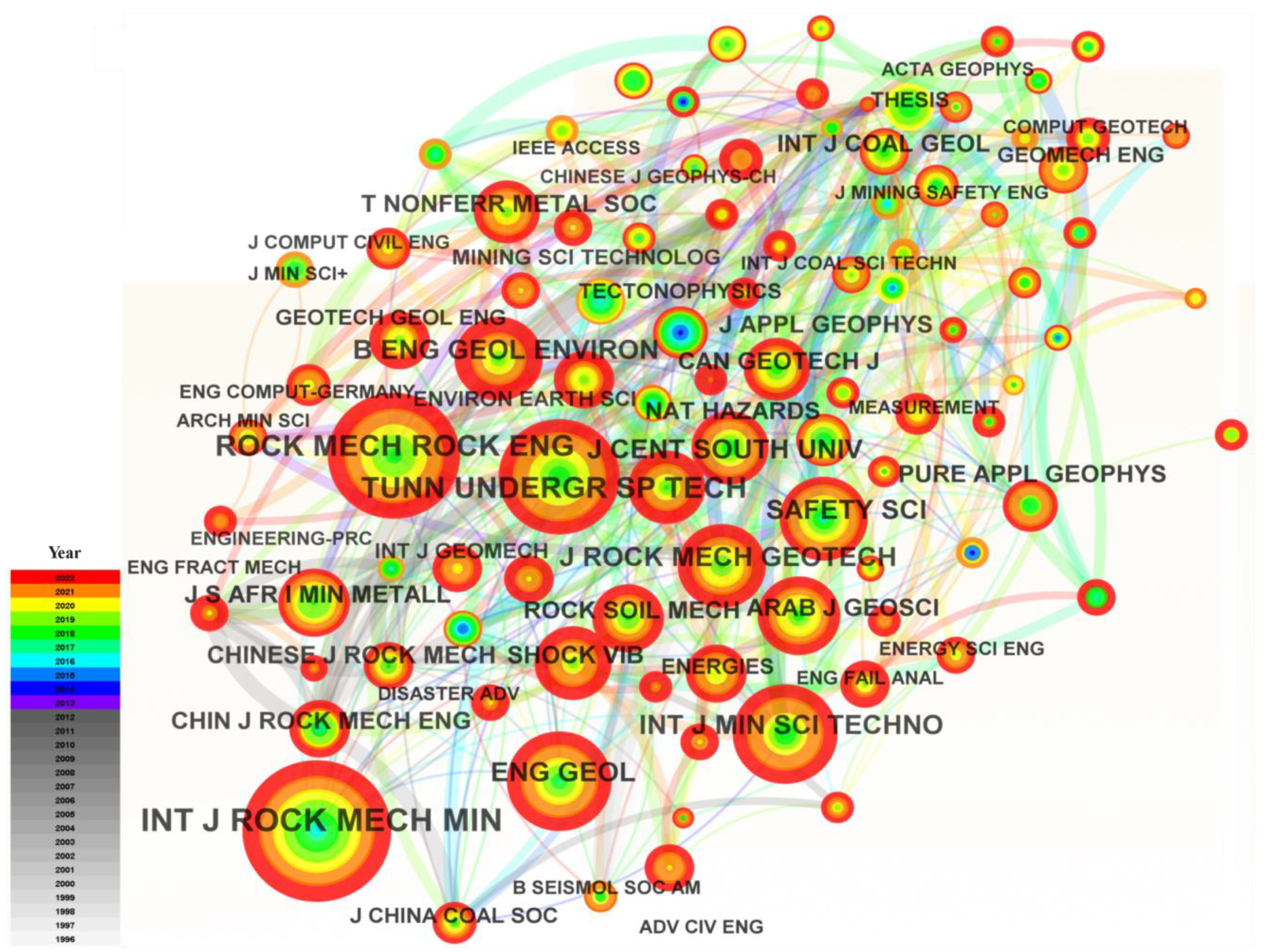

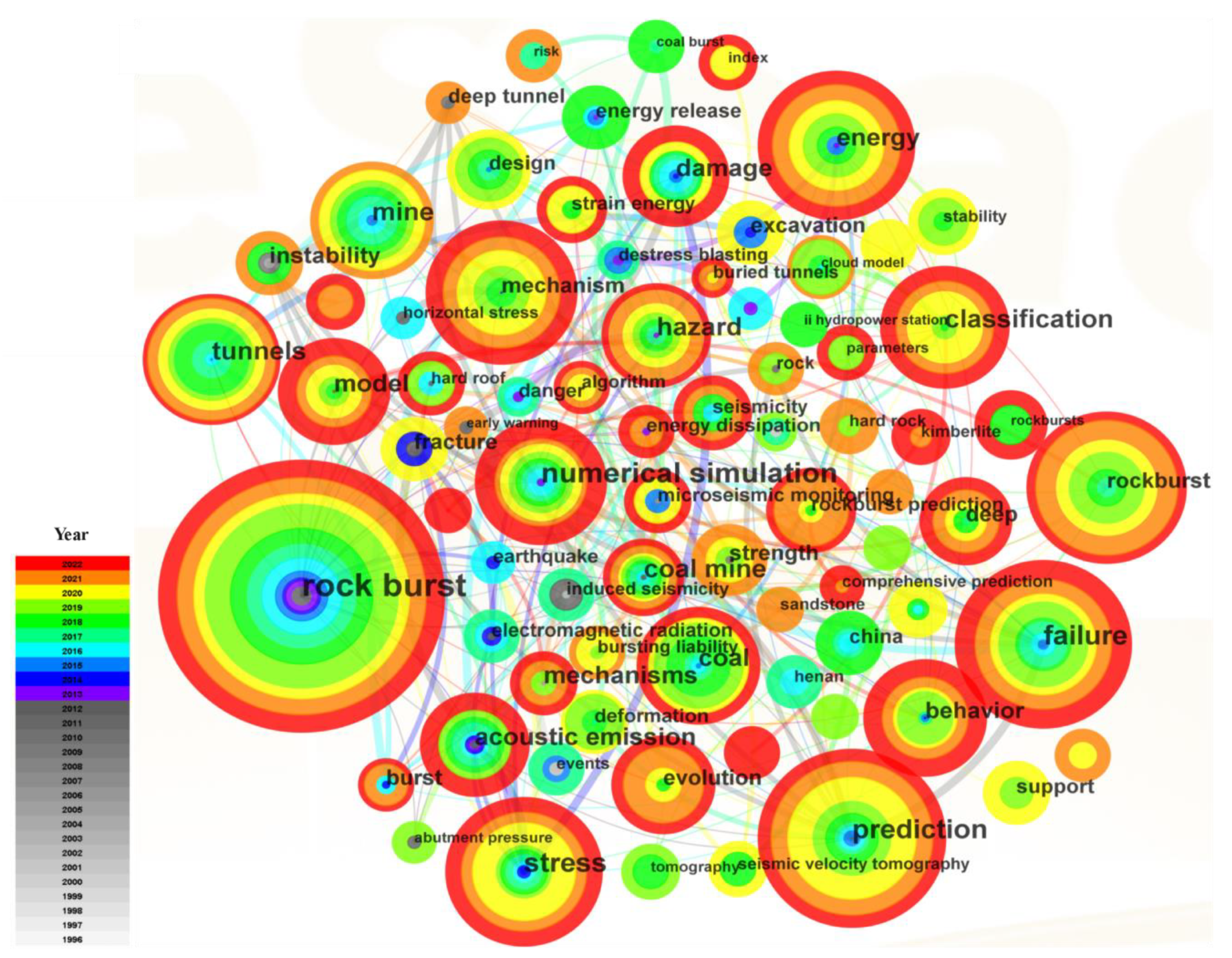
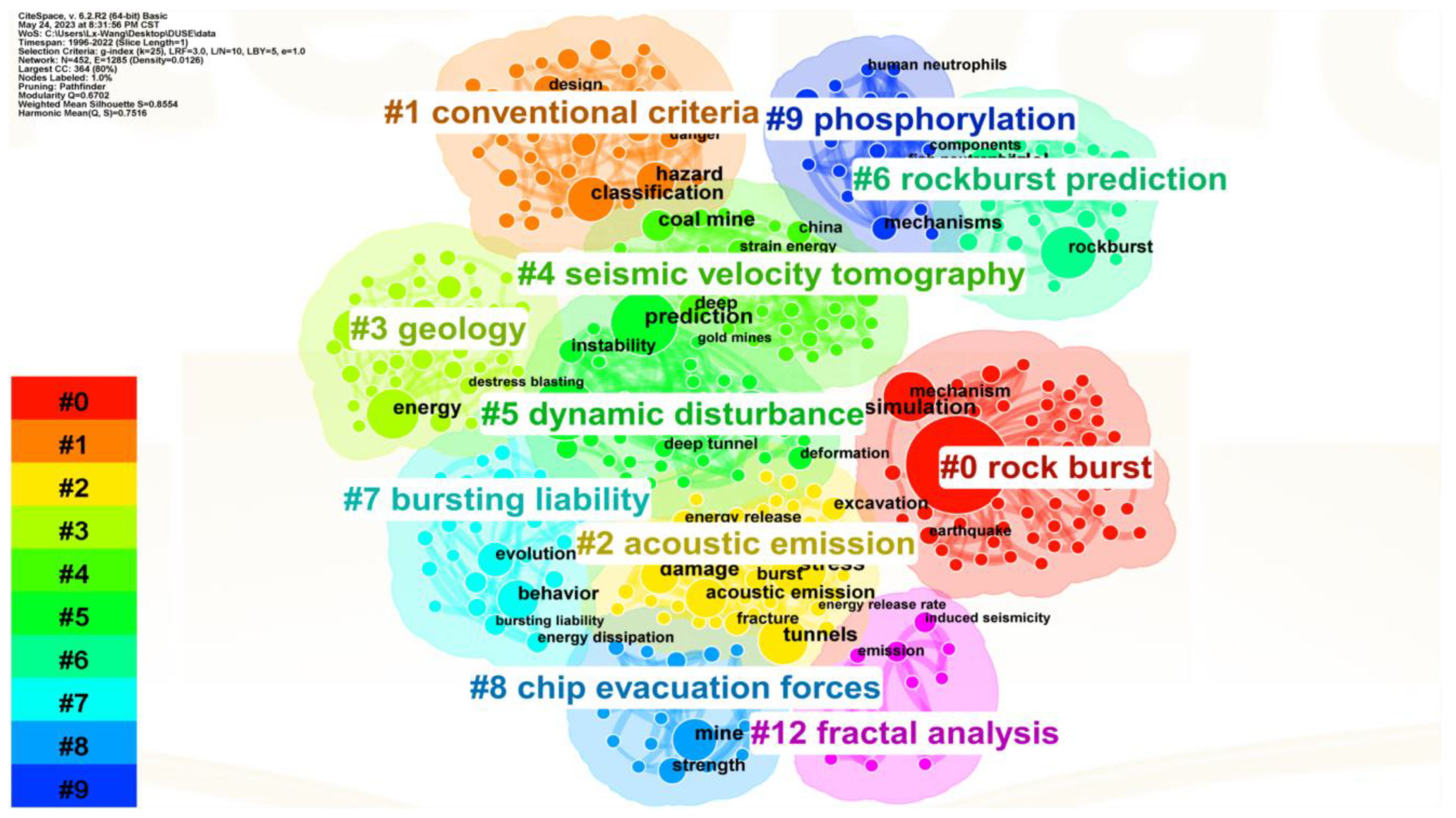
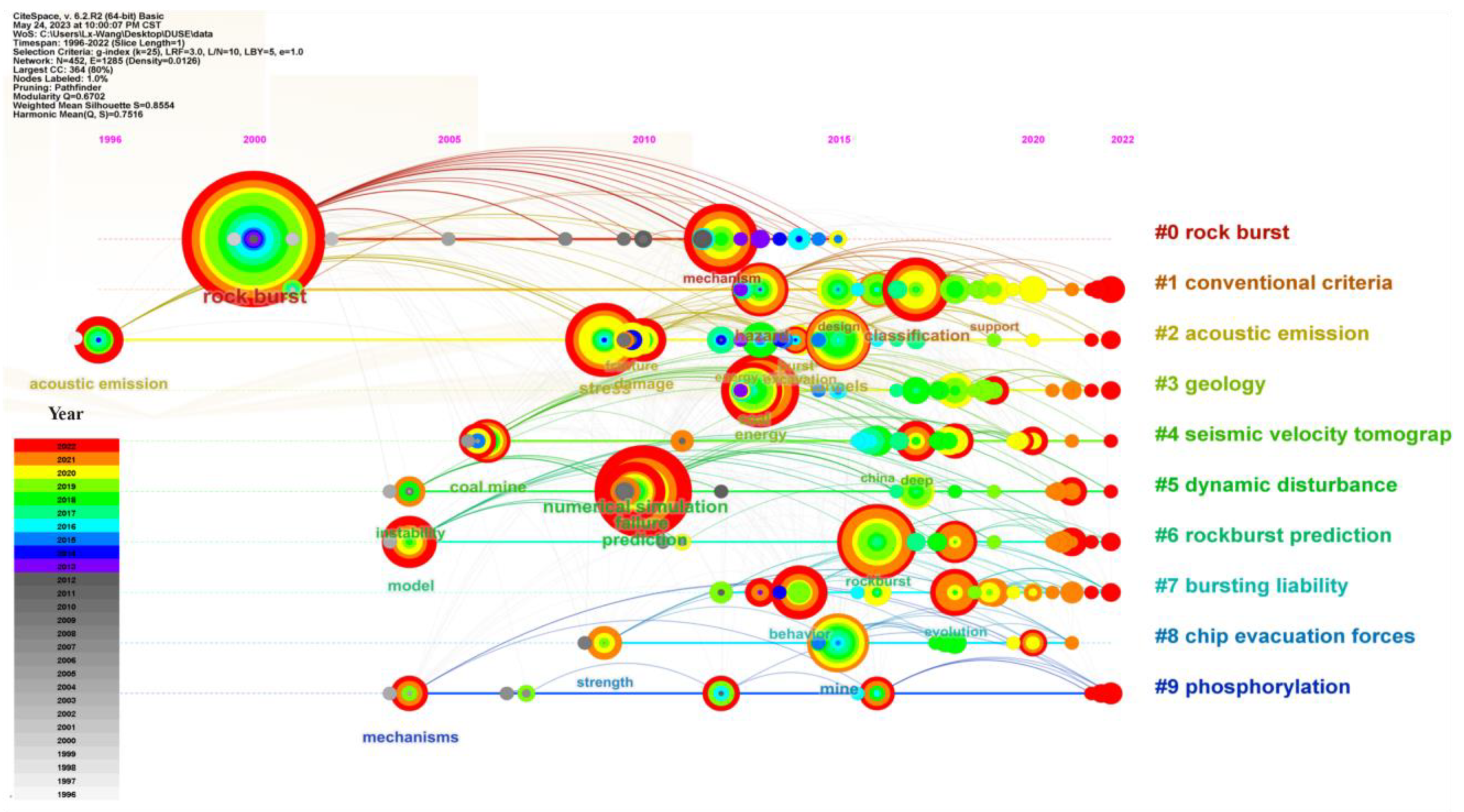
| No. | Country | Publication | Centrality | Year of the First Publication |
|---|---|---|---|---|
| 1 | China | 293 | 1.18 | 2001 |
| 2 | Australian | 20 | 0.51 | 2000 |
| 3 | Russia | 17 | 0.18 | 1996 |
| 4 | USA | 14 | 0.03 | 2002 |
| 5 | Canada | 13 | 0.12 | 2007 |
| 6 | Poland | 9 | 0 | 2008 |
| 7 | Iran | 7 | 0.34 | 2017 |
| 8 | Czech Republic | 5 | 0 | 2004 |
| 9 | Portugal | 4 | 0.01 | 2015 |
| 10 | Norway | 4 | 0.12 | 2012 |
| No. | Institution | Publication | Centrality | Year of the First Publication |
|---|---|---|---|---|
| 1 | China University of Mining and Technology | 115 | 0.45 | 2001 |
| 2 | Shandong University of Science and Technology | 44 | 0.14 | 2006 |
| 3 | University of Science and Technology Beijing | 25 | 0.09 | 2001 |
| 4 | Central South University | 20 | 0.16 | 2005 |
| 5 | Chinese Academy of Sciences | 19 | 0.11 | 2008 |
| 6 | Shandong University | 15 | 0.01 | 2013 |
| 7 | Wuhan Institute of Rock and Soil Mechanics | 14 | 0.01 | 2008 |
| 8 | Anhui University of Science and Technology | 12 | 0.06 | 2015 |
| 9 | Xi’an University of Science and Technology | 10 | 0.05 | 2015 |
| 10 | Guangxi University | 9 | 0.02 | 2010 |
| No. | Author | Publication | Centrality | Year of the First Publication |
|---|---|---|---|---|
| 1 | Wu Cai | 11 | 0.02 | 2014 |
| 2 | Linming Dou | 10 | 0.01 | 2014 |
| 3 | Manchao He | 9 | 0.02 | 2013 |
| 4 | Jianqiang Chen | 7 | 0.01 | 2019 |
| 5 | Enyuan Wang | 6 | 0 | 2016 |
| 6 | Dazhao Song | 5 | 0 | 2012 |
| 7 | Wenlong Zhang | 5 | 0 | 2021 |
| 8 | Xueqiu He | 5 | 0.01 | 2019 |
| 9 | Siyuan Gong | 5 | 0 | 2014 |
| 10 | Anye Cao | 5 | 0 | 2017 |
| No. | Journal Name | Host Country | Cited Times | Influencing Factors (2022) |
|---|---|---|---|---|
| 1 | International Journal of Rock Mechanics and Mining Sciences | England | 283 | 6.849 |
| 2 | Rock Mechanics and Rock Engineering | Austria | 218 | 6.518 |
| 3 | Tunneling and Underground Space Technology | England | 200 | 6.407 |
| 4 | Engineering Geology | Holland | 138 | 6.902 |
| 5 | International Journal of Mining Science and Technology | China | 129 | 7.670 |
| 6 | Journal of Rock Mechanics and Geotechnical Engineering | China | 113 | 5.915 |
| 7 | Bulletin of Engineering Geology and the Environment | Germany | 107 | 4.130 |
| 8 | Safety Science | Netherlands | 176 | 6.392 |
| 9 | Journal of Central South University | China | 92 | 2.392 |
| 10 | Journal of the Southern African Institute of Mining and Metallurgy | Southern African | 88 | 0.640 |
| No. | Title | Author | Cited Times | Year |
|---|---|---|---|---|
| 1 | Predicting Rock Burst Hazard with Incomplete Data Using Bayesian Networks [72] | Ning, Li et al. | 24 | 2017 |
| 2 | A Fuzzy Comprehensive Evaluation Methodology for Rock Burst Forecasting Using Microseismic Monitoring [11] | Wu, Cai et al. | 23 | 2018 |
| 3 | Long-term Prediction of Rockburst Hazard in Deep Underground Openings Using Three Robust Data Mining Techniques [16] | Faradonbeh, Roohollah Shirani et al. | 21 | 2019 |
| 4 | Classification of Rockburst in Underground Projects: Comparison of Ten Supervised Learning Methods [73] | Jian, Zhou et al. | 20 | 2016 |
| 5 | Rockburst Laboratory Tests Database—Application of Data Mining techniques [26] | Manchao, He et al. | 18 | 2015 |
| 6 | A Principal Component Analysis/Fuzzy Comprehensive Evaluation Model for Coal Burst Liability Assessment [74] | Wu, Cai et al. | 16 | 2016 |
| 7 | Intense Rockburst Impacts in Deep Underground Construction and Their Prevention [75] | Mazaira, A. et al. | 15 | 2015 |
| 8 | Rockburst Mechanism and Prediction Based on Microseismic Monitoring [76] | Tian-Hui, Ma et al. | 14 | 2018 |
| 9 | Statistical Assessment of Rock Burst Potential and Contributions of Considered Predictor Variables in the Task [77] | Afraei, Sajjad et al. | 14 | 2018 |
| 10 | Fractal Behaviour of the Microseismic Energy Associated with Immediate Rockbursts in Deep, Hard Rock Tunnels [78] | Xiating, Feng | 13 | 2016 |
| Keywords | Year | Strength | Begin | End | 2010–2022 |
|---|---|---|---|---|---|
| Energy release | 2013 | 2.58 | 2013 | 2018 | -------------------------- |
| Tunnels | 2015 | 4.11 | 2015 | 2018 | -------------------------- |
| Mine | 2015 | 3.25 | 2015 | 2017 | -------------------------- |
| Classification | 2016 | 2.79 | 2016 | 2018 | -------------------------- |
| Deep | 2016 | 2.26 | 2016 | 2017 | -------------------------- |
| Stability | 2018 | 2.51 | 2018 | 2020 | -------------------------- |
| Tomography | 2018 | 2.39 | 2018 | 2019 | -------------------------- |
| Coal | 2013 | 2.22 | 2018 | 2019 | -------------------------- |
| Support | 2019 | 2.75 | 2019 | 2020 | -------------------------- |
| Evolution | 2018 | 2.85 | 2020 | 2022 | -------------------------- |
Disclaimer/Publisher’s Note: The statements, opinions and data contained in all publications are solely those of the individual author(s) and contributor(s) and not of MDPI and/or the editor(s). MDPI and/or the editor(s) disclaim responsibility for any injury to people or property resulting from any ideas, methods, instructions or products referred to in the content. |
© 2023 by the authors. Licensee MDPI, Basel, Switzerland. This article is an open access article distributed under the terms and conditions of the Creative Commons Attribution (CC BY) license (https://creativecommons.org/licenses/by/4.0/).
Share and Cite
Wang, L.; Zhu, Z.; Wu, J.; Zhao, X. Bibliometric Analysis of Research Progress and Perspectives of Deep Underground Rockburst Using Knowledge Mapping Method. Sustainability 2023, 15, 13578. https://doi.org/10.3390/su151813578
Wang L, Zhu Z, Wu J, Zhao X. Bibliometric Analysis of Research Progress and Perspectives of Deep Underground Rockburst Using Knowledge Mapping Method. Sustainability. 2023; 15(18):13578. https://doi.org/10.3390/su151813578
Chicago/Turabian StyleWang, Luxiang, Zhende Zhu, Junyu Wu, and Xinrui Zhao. 2023. "Bibliometric Analysis of Research Progress and Perspectives of Deep Underground Rockburst Using Knowledge Mapping Method" Sustainability 15, no. 18: 13578. https://doi.org/10.3390/su151813578
APA StyleWang, L., Zhu, Z., Wu, J., & Zhao, X. (2023). Bibliometric Analysis of Research Progress and Perspectives of Deep Underground Rockburst Using Knowledge Mapping Method. Sustainability, 15(18), 13578. https://doi.org/10.3390/su151813578









